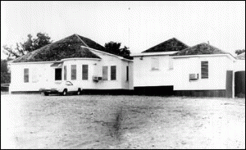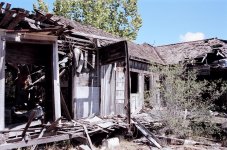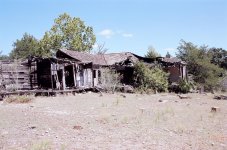Gypsy Heart
Gold Member
WOW! If you could get permission to hunt this property!!!!!!!

The Chicken Ranch
The "Chicken Ranch" in La Grange, Fayette County, made famous by the Broadway
musical The Best Little Whorehouse in Texas, was perhaps the oldest continuously
running brothel in the nation. Institutionalized prostitution in La Grange can be traced back to 1844, when a widow, "Mrs. Swine", brought three young women from New Orleans and settled in a small hotel near the saloon. Mrs. Swine became the first madam and began a tradition of interaction with the community and local lawmen that lasted almost 130 years. She and the girls and women who worked for her carried on a lucrative business, using the hotel lobby for entertaining and a room upstairs for services, until the Civil War, when she and a faithful prostitute named Tillie were run out of town as Yankees and traitors. After the war, prostitution continued to operate in
conjunction with the saloons in La Grange, but no official records were kept. By the
end of the nineteenth century, prostitution had moved out of the hotels and into a red- light district on the banks of the Colorado River. There Miss Jessie Williams (born Faye Stewart) bought a small house soon after her arrival from Waco in 1905. She continued the custom set by her predecessor of good relations with the law and ran the only respectable house on the banks of the Colorado River; she admitted politicians and lawmen but excluded drunkards. Through her connections she learned of an impending crusade against the red-light district, sold the house she owned in Waco, and bought two dwellings and eleven acres outside of the city limits of La Grange and two blocks
from the Houston-Austin highway. This became the location of the Chicken Ranch.
In 1917 two sisters arrived at the house and were taken in and promoted to "middle- management" positions by Miss Jessie. They were in charge of public relations and sent packages and letters to local boys fighting in World War I. One of the sisters eventually married an older, wealthy customer and moved to San Antonio, where she became, as one author says, "a beloved benefactor and patron of the arts". The other sister stayed in her middle-management position until her death. As the war ended and America entered the twenties, automobiles made the establishment accessible to many more customers. New prostitutes came and necessitated more rooms and new furniture. The rooms were simply built onto the main house in a haphazard fashion as needed, a style that continued until the closing of the place. Miss Jessie stayed on good terms with the sheriff, Will Loessin, who visited every evening to pick up gossip and get information on criminals who had visited the whorehouse and bragged of their exploits. Many crimes in La Grange were solved in this way. While the sheriff kept a tight grip on criminals, Miss Jessie ruled the house with a firm hand. Nothing exotic was
allowed, and none of the bedroom doors had locks on them. Miss Jessie would walk the halls, and if she heard a customer giving one of her girls a hard time she would chase him out of the room and house with an iron rod and perhaps never admit him again.
As the Great Depression hit and the economy fell, Miss Jessie was forced to lower her prices. Though initially she still had plenty of clients, as times grew harder, customers were not so plentiful and the girls grew hungry. Miss Jessie therefore began the "poultry standard" of charging "one chicken for one screw". Soon chickens were everywhere, and the establishment became known as the Chicken Ranch. The girls were never hungry. Miss Jessie supplemented the income by selling surplus chickens and eggs. The economy began to turn around as the Civilian Conservation Corps began construction of Camp Swift near La Grange, and the shortage of men and money declined. The establishment used the same public-relations tactics in World War II as in the First World War, and the ranch began an economic recovery from the depression.
As the war ended, Miss Jessie was confined to a wheelchair by arthritis but still ruled
the house with her iron rod. She did so into the 1950's, when she was confined to her bed and cared for by her longtime nurse. She spent her last few years with her wealthy sister in San Antonio and died in 1961 at the age of eighty.
Edna Milton had arrived at the Chicken Ranch from Oklahoma in 1952 at the age of
twenty-three. She soon took over for Miss Jessie and proved just as capable and
entrepreneurial. When she bought the ranch from Miss Jessie's heirs for $30,000 - much more than the property value - she already had established herself as a competent madam. She had a good relationship with the new sheriff, T.J. Flournoy, who had been elected in 1946 and had immediately put in a direct line to the Chicken Ranch, so he could replace the nightly visits of his predecessor with nightly calls. Edna also interacted with the community in the same ways Jessie had: social contact between the girls and the residents of La Grange was forbidden; however, the girls saw the doctor weekly and were allowed to shop with local merchants; and commodities and supplies were bought from local stores on a rotating basis. Edna also continued Jessie's custom of giving money to local civic causes and became of the town's largest philanthropists. The generosity of her donations points to the success of the ranch.
During the 1950's the ranch reached its sixteen-girl maximum. On some weekends there was a line at the door, made of students and soldiers from the nearby military bases.
One base even supplied transportation via helicopter to the ranch. A visit to the
Chicken Ranch also became part of freshman initiations at Texas A&M.
A door attendant admitted only white, presentable, and sober men into the parlor,
where chairs stood on both sides of the room. No cursing or drinking was allowed of the men, or the women for that matter. Edna charged a quarter for the jukebox, seventy-five cents for cigarettes, and a dollar for a Coke, steep prices for the sixties. The women asked for music and Cokes to promote business. The going rate for their services was fifteen dollars for fifteen minutes, though more expensive options were added in the sixties. A girl would have from five to twenty customers a day. After giving an estimated 75% to Edna, the women still made $300 a week and had no expenses. Edna took care of taxes, insurance, utilities, food (two meals a day), weekly doctor visits, two attendants, maids, a cook and laundry bills. Even before profits from the Cokes, cigarettes and jukebox, it has been estimated that the ranch had an income of more than $500,000 a year. All new employees were fingerprinted and photographed by Sheriff Flournoy before they could start work, and a criminal record of any kind prevented their employment. Flournoy caught a few women wanted on warrants this way. Once at the ranch, the women had to subscribe to strict rules written by Miss Edna.
The Chicken Ranch continued operating successfully until mid-1973. That year,
consumer-affairs reporter Marvin Zindler from KTRK-TV in Houston ran a week-long
expose on the ranch. He claimed that his motive was inaction on the part of the Texas Department of Public Safety and local law officers to combat the organized crime and corruption allegedly evident at the ranch. All of the attention drawn to the ranch forced the governor, Dolph Briscoe, to meet with the head of the DPS, the state attorney general, and Zindler. At the meeting it was disclosed that the DPS had run a two-month surveillance on the Chicken Ranch and had failed to find evidence of connection with organized crime. However, the pressure on the governor was such that he could not ignore the problem. He scheduled a meeting with Sheriff Jim Flournoy and ordered the house closed. The sheriff, along with some of the citizens of La Grange, saw little reason to close the ranch, but thought he had to do it anyway. He informed Edna of the situation, and by Wednesday morning of the week following Zindler's expose, August 1, 1973, the ranch was closed and the women had left.
Flournoy left for his meeting with the governor with a petition signed by nearly 3,000 people, but upon arriving was informed that the governor had canceled the meeting when he heard the house was closed. Most of the ranch's employees had headed for Austin or Houston; only Edna and a few maids were left. Edna attempted to buy ahouse in La Grange, but her down payment was returned. She subsequently got married and moved to an East Texas town where her husband owned several restaurants.
Although the Chicken Ranch was officially closed, the story was not over. Customers
showed up for more than two years looking for the place. Zindler also came back for a follow-up story and in the midst of an argument with Sheriff Flournoy was pushed down.
This resulted in a $3 million lawsuit against the sheriff. Many local people began
contributing to Flournoy's cause by selling T-shirts and bumper stickers. Flournoy
settled out of court for much less than $3 million. The musical about the ranch was
very successful. Edna had a silent role in the Broadway production, which was later
turned into a movie. Two lawyers from Houston bought the building and land and in 1977 moved part of the building, in its original condition, to Dallas to open a restaurant named the Chicken Ranch. It opened in September 1977 with Miss Edna as the hostess, the building and furniture in their original condition, and a menu of mainly chicken dishes. The restaurant closed in January 1978. The building and furniture were auctioned off at the site of the restaurant in late June of that year in a foreclosure sale ordered by the Small Business Administration. Sheriff Flournoy resigned in 1980, saying that he and his wife were sick of hearing about the Chicken Ranch and did not want to hear the name again. When he died in October 1982, his funeral was attended by Lt. Governor Bill Hobby and nearly 100 lawmen. He was credited with solving every murder and bank robbery in Fayette County during his 34 year term. The Chicken Ranch had helped his criminal investigations.
The preceding article is from the Handbook of Texas Online
The Chicken Ranch
The "Chicken Ranch" in La Grange, Fayette County, made famous by the Broadway
musical The Best Little Whorehouse in Texas, was perhaps the oldest continuously
running brothel in the nation. Institutionalized prostitution in La Grange can be traced back to 1844, when a widow, "Mrs. Swine", brought three young women from New Orleans and settled in a small hotel near the saloon. Mrs. Swine became the first madam and began a tradition of interaction with the community and local lawmen that lasted almost 130 years. She and the girls and women who worked for her carried on a lucrative business, using the hotel lobby for entertaining and a room upstairs for services, until the Civil War, when she and a faithful prostitute named Tillie were run out of town as Yankees and traitors. After the war, prostitution continued to operate in
conjunction with the saloons in La Grange, but no official records were kept. By the
end of the nineteenth century, prostitution had moved out of the hotels and into a red- light district on the banks of the Colorado River. There Miss Jessie Williams (born Faye Stewart) bought a small house soon after her arrival from Waco in 1905. She continued the custom set by her predecessor of good relations with the law and ran the only respectable house on the banks of the Colorado River; she admitted politicians and lawmen but excluded drunkards. Through her connections she learned of an impending crusade against the red-light district, sold the house she owned in Waco, and bought two dwellings and eleven acres outside of the city limits of La Grange and two blocks
from the Houston-Austin highway. This became the location of the Chicken Ranch.
In 1917 two sisters arrived at the house and were taken in and promoted to "middle- management" positions by Miss Jessie. They were in charge of public relations and sent packages and letters to local boys fighting in World War I. One of the sisters eventually married an older, wealthy customer and moved to San Antonio, where she became, as one author says, "a beloved benefactor and patron of the arts". The other sister stayed in her middle-management position until her death. As the war ended and America entered the twenties, automobiles made the establishment accessible to many more customers. New prostitutes came and necessitated more rooms and new furniture. The rooms were simply built onto the main house in a haphazard fashion as needed, a style that continued until the closing of the place. Miss Jessie stayed on good terms with the sheriff, Will Loessin, who visited every evening to pick up gossip and get information on criminals who had visited the whorehouse and bragged of their exploits. Many crimes in La Grange were solved in this way. While the sheriff kept a tight grip on criminals, Miss Jessie ruled the house with a firm hand. Nothing exotic was
allowed, and none of the bedroom doors had locks on them. Miss Jessie would walk the halls, and if she heard a customer giving one of her girls a hard time she would chase him out of the room and house with an iron rod and perhaps never admit him again.
As the Great Depression hit and the economy fell, Miss Jessie was forced to lower her prices. Though initially she still had plenty of clients, as times grew harder, customers were not so plentiful and the girls grew hungry. Miss Jessie therefore began the "poultry standard" of charging "one chicken for one screw". Soon chickens were everywhere, and the establishment became known as the Chicken Ranch. The girls were never hungry. Miss Jessie supplemented the income by selling surplus chickens and eggs. The economy began to turn around as the Civilian Conservation Corps began construction of Camp Swift near La Grange, and the shortage of men and money declined. The establishment used the same public-relations tactics in World War II as in the First World War, and the ranch began an economic recovery from the depression.
As the war ended, Miss Jessie was confined to a wheelchair by arthritis but still ruled
the house with her iron rod. She did so into the 1950's, when she was confined to her bed and cared for by her longtime nurse. She spent her last few years with her wealthy sister in San Antonio and died in 1961 at the age of eighty.
Edna Milton had arrived at the Chicken Ranch from Oklahoma in 1952 at the age of
twenty-three. She soon took over for Miss Jessie and proved just as capable and
entrepreneurial. When she bought the ranch from Miss Jessie's heirs for $30,000 - much more than the property value - she already had established herself as a competent madam. She had a good relationship with the new sheriff, T.J. Flournoy, who had been elected in 1946 and had immediately put in a direct line to the Chicken Ranch, so he could replace the nightly visits of his predecessor with nightly calls. Edna also interacted with the community in the same ways Jessie had: social contact between the girls and the residents of La Grange was forbidden; however, the girls saw the doctor weekly and were allowed to shop with local merchants; and commodities and supplies were bought from local stores on a rotating basis. Edna also continued Jessie's custom of giving money to local civic causes and became of the town's largest philanthropists. The generosity of her donations points to the success of the ranch.
During the 1950's the ranch reached its sixteen-girl maximum. On some weekends there was a line at the door, made of students and soldiers from the nearby military bases.
One base even supplied transportation via helicopter to the ranch. A visit to the
Chicken Ranch also became part of freshman initiations at Texas A&M.
A door attendant admitted only white, presentable, and sober men into the parlor,
where chairs stood on both sides of the room. No cursing or drinking was allowed of the men, or the women for that matter. Edna charged a quarter for the jukebox, seventy-five cents for cigarettes, and a dollar for a Coke, steep prices for the sixties. The women asked for music and Cokes to promote business. The going rate for their services was fifteen dollars for fifteen minutes, though more expensive options were added in the sixties. A girl would have from five to twenty customers a day. After giving an estimated 75% to Edna, the women still made $300 a week and had no expenses. Edna took care of taxes, insurance, utilities, food (two meals a day), weekly doctor visits, two attendants, maids, a cook and laundry bills. Even before profits from the Cokes, cigarettes and jukebox, it has been estimated that the ranch had an income of more than $500,000 a year. All new employees were fingerprinted and photographed by Sheriff Flournoy before they could start work, and a criminal record of any kind prevented their employment. Flournoy caught a few women wanted on warrants this way. Once at the ranch, the women had to subscribe to strict rules written by Miss Edna.
The Chicken Ranch continued operating successfully until mid-1973. That year,
consumer-affairs reporter Marvin Zindler from KTRK-TV in Houston ran a week-long
expose on the ranch. He claimed that his motive was inaction on the part of the Texas Department of Public Safety and local law officers to combat the organized crime and corruption allegedly evident at the ranch. All of the attention drawn to the ranch forced the governor, Dolph Briscoe, to meet with the head of the DPS, the state attorney general, and Zindler. At the meeting it was disclosed that the DPS had run a two-month surveillance on the Chicken Ranch and had failed to find evidence of connection with organized crime. However, the pressure on the governor was such that he could not ignore the problem. He scheduled a meeting with Sheriff Jim Flournoy and ordered the house closed. The sheriff, along with some of the citizens of La Grange, saw little reason to close the ranch, but thought he had to do it anyway. He informed Edna of the situation, and by Wednesday morning of the week following Zindler's expose, August 1, 1973, the ranch was closed and the women had left.
Flournoy left for his meeting with the governor with a petition signed by nearly 3,000 people, but upon arriving was informed that the governor had canceled the meeting when he heard the house was closed. Most of the ranch's employees had headed for Austin or Houston; only Edna and a few maids were left. Edna attempted to buy ahouse in La Grange, but her down payment was returned. She subsequently got married and moved to an East Texas town where her husband owned several restaurants.
Although the Chicken Ranch was officially closed, the story was not over. Customers
showed up for more than two years looking for the place. Zindler also came back for a follow-up story and in the midst of an argument with Sheriff Flournoy was pushed down.
This resulted in a $3 million lawsuit against the sheriff. Many local people began
contributing to Flournoy's cause by selling T-shirts and bumper stickers. Flournoy
settled out of court for much less than $3 million. The musical about the ranch was
very successful. Edna had a silent role in the Broadway production, which was later
turned into a movie. Two lawyers from Houston bought the building and land and in 1977 moved part of the building, in its original condition, to Dallas to open a restaurant named the Chicken Ranch. It opened in September 1977 with Miss Edna as the hostess, the building and furniture in their original condition, and a menu of mainly chicken dishes. The restaurant closed in January 1978. The building and furniture were auctioned off at the site of the restaurant in late June of that year in a foreclosure sale ordered by the Small Business Administration. Sheriff Flournoy resigned in 1980, saying that he and his wife were sick of hearing about the Chicken Ranch and did not want to hear the name again. When he died in October 1982, his funeral was attended by Lt. Governor Bill Hobby and nearly 100 lawmen. He was credited with solving every murder and bank robbery in Fayette County during his 34 year term. The Chicken Ranch had helped his criminal investigations.
The preceding article is from the Handbook of Texas Online











